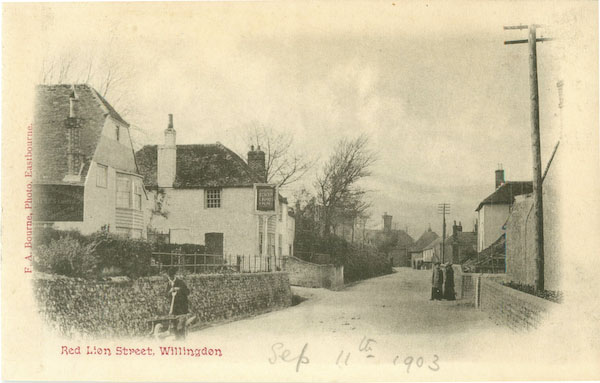Frederick Arthur Bourne

Red Lion Street (now Wish Hill), Willingdon
Photographer, 19 Langney Road, Eastbourne. Bourne was born at his parents' home at 2 Castle View in Hastings on January 30, 1860. His father was Robert Bourne, a master carpenter, and his mother Charlotte Bourne, née Mitchell. By 1883 he was working as a photographer at Eastbourne, probably as an employee of an existing studio. In April he married Mary Adams, who was two years his junior, and daughter of Thomas Adams, a "railway servant". It was an unlucky marriage: in late December, Mary gave birth to a daughter, Mary Madeline M. Bourne, but developed peritonitis and died at home at 46 Langney Road in Eastbourne on December 26, 1883. Her daughter's birth was registered early the next year.
The 1891 census records that Bourne and his daughter were boarding with a family called Gale at 7 Langney Road. The head of the household, Charles H. Gale, and his wife, Sarah, had both been born in Cornwall. Charles was working in Eastbourne as a draper's porter. The couple's 9-year-old daughter, Hannah, hopefully made a good playmate for Mary Bourne.
In 1894 Bourne founded the "Rembrandt Studio" in Langney Road, which he continued until his retirement. The 1901 census reveals that he remained a widower and that he and Mary were still boarding with the Gales. Mary had become a draper's assistant. Charles Gale was working as a photographer, most probably as a colleague of Bourne since the census lists him as "employed", and not as an "employer". Bourne, by contrast, is described as a shopkeeper and employer. Also staying in the house was John Wills, a photographer and nephew of Charles Gale, from Houghton-le-Spring in County Durham.
In 1901 the Gales were living at 17 Langney Road, not 7 as in 1891. They had not actually moved - new houses had been built, necessitating renumbering. Bourne's studio was located at Number 19.
Bourne published both printed and real photographic cards of the Eastbourne area, but very few of the town itself. A series of black and white collotype cards of Willingdon and Wannock are believed to have gone on sale by autumn 1903. Wide borders surround the soft edged pictures, and the captions are printed in red with "ø" in place of "o", suggesting a German source. The cards are labelled up the left side: "F. A. Bourne, Photo, Eastbourne".
Some black and white collotype cards of Wannock, sold at Thomas's Tea Gardens, have a single, white basal border. The captions are printed in black, and the cards are labelled "F.A. Bourne Series". A 1906 postmark has been seen. A black and white collotype of Wannock Glen, without a border and labelled "F. A. Bourne, Eastbourne" in the bottom right corner of the picture, may be a separate, later issue.
Bourne also arranged for a series of at least six black and white collotypes of Pevensey and Westham with fake clouds to be printed in Germany. The cards are labelled in green on the back "F. A. Bourne, The Rembrandt Studio, Eastbourne".
Perhaps the best known of Bourne's printed cards, a collotype of "Mr and Mrs Breach - old inhabitants of Pevensey" is a dignified and sensitive portrait of a venerable couple, one dressed in black, the other in contrasting white.
Bourne seems to have published printed cards of Eastbourne only in response to special commissions, for example from the YMCA who ordered both halftone and collotype cards of their building. However, he provided many photographs of the town for the "Borough" Guide to Eastbourne, undated, but c. 1910. He also illustrated Robinson's Sussex Blue Book and Court Directory of 1905.
Bourne's real photographic cards are of varied style. A black and white real photographic card of a funeral procession, for example, lacks a caption or a border, but is labelled "Frederick A. Bourne, photographer, Eastbourne" on the reverse. Another borderless black and white real photographic with the same label has a handwritten caption explaining that it shows Territorial Army Dental Staff at Eastbourne in April 1918. A card of Hailsham Town Band in 1914 has both a caption and a border.
Of problematic origin are some real photographic cards showing, for example "Rosborough School Sports 1926" (labelled "F. A. Bourne") and the devastated interior of All Saints Church in Eastbourne, which caught fire on September 29, 1927 (blind stamped "Fredk. A. Bourne, Eastbourne"). These cards could give the impression that Bourne continued to work after the mid 1920s, but Pike's 1928-29 Eastbourne Directory indicates that he had retired and that John Wills had taken over the Langney Road Studio retaining the Rembrandt and Bourne names. A sepia-tinted real photographic card of the Beachy Head cliffs and Belle Toute lighthouse, which has Bourne's name and address on the back, also dates from the late 1920s judging from clothing styles, and must be assumed to be a John Wills production. Very similar in design is a card of the Central Bandstand in Eastbourne that was not completed until August 1935. Other assumed Wills cards are a sepia real photographic of Queenswood School at Eastbourne (a 1932 postmark has been noted) and some black and white real photographics of the Annecy Convent at Seaford, again with Bourne's name and address on the back. Another real photographic card, which shows Young Methodist holidaymakers at Eastbourne Links, is dated October 1937.
Around the start of the Second World War the Rembrandt Studio changed its name to "Wills' Studio (F. A. Bourne)". John Wills was still running it when Kelly's 1938 Sussex Directory was compiled, but by 1946, a Percy Wills, presumably his son, had taken over. Percy continued to be in charge in 1963.
To directory of publishersTo gallery
Design: Lucid Design
© www.sussexpostcards.info
